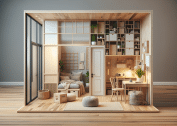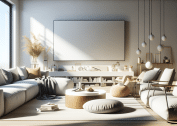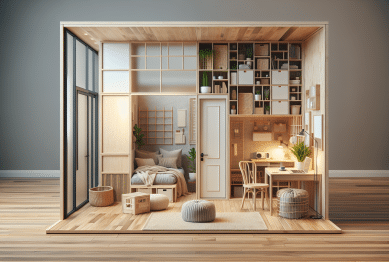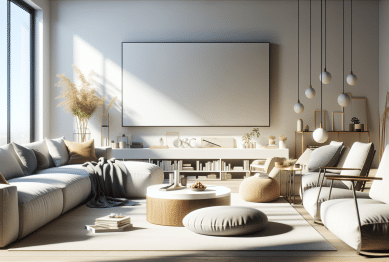Discover how the practice of minimalism can help you reclaim calm, clarity, and even more time for yourself. This guide explores practical tips, design ideas, and lifestyle shifts that make minimalism accessible, rewarding, and surprisingly joyful for individuals looking to simplify in today’s fast-paced world.
The Essence of Minimalism for Everyday Life
Minimalism is more than just a design trend. It’s a conscious lifestyle choice where less truly becomes more, and each item or experience adds genuine value. Many individuals are drawn to the minimalist lifestyle because it promises a reprieve from overwhelm, clutter, and constant consumer pressure. At its core, minimalism encourages reflection—asking what genuinely matters and letting go of what doesn’t. Adopting minimalism pushes individuals to embrace intentional living, which can bring greater satisfaction, reduced stress, and increased ability to focus on meaningful relationships and passions.
This lifestyle often begins with the decluttering of physical belongings, but quickly expands to other areas—time commitments, digital habits, and even relationships. The benefits go beyond tidy spaces. Research suggests that simplifying environments can reduce decision fatigue and increase well-being (Source: https://www.psychologytoday.com/intl/blog/the-uncluttered-mind/201507/the-power-less). By focusing on what’s essential, individuals foster greater clarity and freedom. Minimalists tend to experience deeper appreciation for the items and people kept in their lives, shifting attention from quantity to quality.
Minimalism’s appeal is universal. Whether living in a small apartment or a spacious home, anyone can tailor this approach to fit personal needs and goals. The practice is about versatility and flexibility, not prescriptive rules. It’s for those craving a calmer mind, more money saved, and extra time for hobbies, travel, and personal fulfillment. For many, minimalism is both a practical solution and a philosophy, promising more meaning through mindful living and intentional simplicity.
Decluttering Strategies: Where to Start First
Embarking on a minimalist journey often begins with decluttering. This first step might feel daunting, but breaking it down by category—such as clothes, books, and digital files—can make it manageable. The KonMari method, created by Marie Kondo, remains a popular approach, focusing on keeping items that ‘spark joy’ while discarding the rest (Source: https://konmari.com/about-the-konmari-method/). Instead of tackling an entire home at once, consider starting small, like a single drawer or desktop, and celebrating progress. These wins build momentum.
Establishing clear criteria for what to keep plays a big role. Ask if an item is useful, beautiful, or has emotional value. If it doesn’t serve a true purpose, it may be time to let go. This isn’t just about things—digital clutter, such as endless emails or unused apps, can also affect mental space. Regularly decluttering devices brings noticeable mental clarity and reduced stress. Over time, these routines foster a sense of control and renewed energy within daily life.
For many, letting go of sentimental items presents the biggest challenge. One approach is to take photos, preserving the memory while freeing up physical space. Others find value in sharing items with friends or charities, knowing their belongings will be appreciated elsewhere. These acts help shift focus from loss to generosity and gratitude. As decluttering becomes habitual, the process grows easier—a natural part of maintaining a minimalist, joyful home.
Designing Minimalist Spaces That Inspire Calm
Minimalist design shapes serene, functional, and visually soothing spaces. The philosophy relies on clean lines, neutral colors, and an emphasis on function rather than decoration. Even a small apartment can feel open and welcoming by removing excess furniture and opting for pieces that multitask. Natural light is prioritized, and surfaces are left intentionally uncluttered, creating an airy atmosphere ideal for relaxation and focus (Source: https://www.housebeautiful.com/room-decorating/colors/tips/a2191/decorating-with-white-0309/).
Even beginners can infuse minimalist style without costly renovations. Rugs, throw pillows, or artwork in subtle hues can offer warmth without visual overload. Smart storage keeps essentials out of sight but within easy reach. Integrated furniture—like benches with hidden compartments—offers comfort and utility. Plants also play a role, bringing softness and vitality into minimalist spaces, all while purifying air and reducing stress. Design experts often recommend a ‘one in, one out’ rule to help prevent build-up of possessions and keep surroundings intentional and fresh.
Lighting and layout matter. Adjustable lighting, from floor lamps to pendant fixtures, creates ambiance at any time of day. Keep traffic pathways open and prioritize furniture arrangement that supports conversation and relaxation. In children’s rooms or creative spaces, allow for a few personal touches—artwork, favorite books, or cherished objects carefully curated. These choices demonstrate that minimalism does not mean emptiness, but rather harmony and purpose within every visual detail.
Building Lasting Minimalist Habits
Adopting minimalism extends beyond homes and wardrobes. Everyday habits, like mindful shopping and intentional scheduling, reinforce a simpler and happier lifestyle. Practicing conscious consumption starts with pausing before purchases and considering if an item fills a real need. Shopping with intention—choosing durability and timeless style over fast fashion—minimizes clutter and supports budget-friendly choices. Keeping grocery and errand lists also prevents impulse buys and reduces waste (Source: https://www.ncbi.nlm.nih.gov/pmc/articles/PMC7928943/).
Minimalism shapes more than possessions. Digital minimalism, for example, involves curating social media feeds, turning off unnecessary notifications, and designing phone screens to show only essential apps. Reducing digital noise enhances focus and reduces stress. Many find that limiting digital commitments, unfollowing irrelevant online content, and setting boundaries for screen time lead to better sleep and deeper personal connections. These habits can transform routines and contribute to a sense of calm throughout the day.
Time is a valuable resource. Minimalists often assess weekly commitments, prioritizing what brings fulfillment and letting go of obligations that drain energy. Saying ‘no’ becomes easier as individuals embrace the deeper ‘yes’ to things that matter. Weekly planning—like batching chores or preparing meals in advance—creates more space for hobbies, health, and relaxation. Over time, these small changes compound, translating into meaningful, sustainable shifts that enrich daily existence.
Minimalism Meets Entertainment: Enjoy More With Less
Minimalism isn’t about giving up leisure or fun. In fact, it can make hobbies, travel, and entertainment more enjoyable. Choosing to focus on a select few enriching activities helps amplify enjoyment and avoid scattered attention. Experiences—like board game nights with close friends, nature hikes, or movie marathons—often bring more satisfaction than accumulating more things. Minimalists often embrace ‘slow entertainment,’ savoring books, music, or art with greater presence (Source: https://www.psychologytoday.com/us/blog/the-new-grief/201905/in-praise-slow-entertainment).
Streamlining entertainment also applies to digital subscriptions and social calendars. Rather than juggling multiple streaming platforms or events, selecting a few favorites simplifies decision-making and frees up time for in-person connections. Many people find joy in revisiting classic films, exploring curated playlists, or participating in local arts and culture events. This approach encourages deeper engagement and avoids the stress of keeping up with endless options.
Minimalism values quality over quantity in how individuals spend their free hours. Whether it’s pursuing creative passions or exploring new outdoor adventures, minimalists report greater fulfillment from a handful of meaningful experiences. This shift promotes a healthier balance, leaving more time to rest and recharge without the pressure of constant stimulation or FOMO (fear of missing out). It’s a new way to savor what matters most in life’s lighter moments.
Minimalism and Wellness: Space for Mental Clarity
There’s a growing body of research connecting minimalism to enhanced well-being. Simplifying surroundings is linked to lower cortisol levels, improved focus, and reduced anxiety. As homes become less cluttered, minds follow suit, resulting in greater calm and emotional resilience (Source: https://www.mayoclinichealthsystem.org/hometown-health/speaking-of-health/how-minimalism-can-benefit-mental-health). Less time cleaning or managing stuff means more space for mindfulness, gratitude, and meaningful relationships. These effects add up, especially in times of change or uncertainty.
Minimalist living can also support physical health. Fewer household objects make cleaning easier, reducing allergens and creating a healthier living environment. Minimal spaces are often easier to organize, so essentials like water bottles, sneakers, or healthy snacks are more accessible. This can promote healthier routines, from regular walks to invigorating home workouts without distractions. It’s about setting up an environment that makes well-being effortless.
Emotional wellness does not require perfection. Minimalism invites experimentation—accepting setbacks and learning what level of simplicity feels right in each season of life. The satisfaction comes not from strict adherence, but from the freedom to adapt, try new things, and focus on what brings genuine happiness. It’s a gentle reminder that our spaces and schedules can be designed intentionally to support whole-person wellness over time.
References
1. Cherry, K. (n.d.). The Power of Less: Simplifying Life to Reduce Stress and Increase Productivity. Psychology Today. Retrieved from https://www.psychologytoday.com/intl/blog/the-uncluttered-mind/201507/the-power-less
2. Kondo, M. (n.d.). About the KonMari Method. KonMari. Retrieved from https://konmari.com/about-the-konmari-method/
3. Quercia, P., & Gubiani, R. (2021). Influence of Clean Environments on Wellbeing. National Institutes of Health. Retrieved from https://www.ncbi.nlm.nih.gov/pmc/articles/PMC7928943/
4. The Color White: Decorating Tips and Ideas. (n.d.). House Beautiful. Retrieved from https://www.housebeautiful.com/room-decorating/colors/tips/a2191/decorating-with-white-0309/
5. The Benefits and Joy of Slow Entertainment. (n.d.). Psychology Today. Retrieved from https://www.psychologytoday.com/us/blog/the-new-grief/201905/in-praise-slow-entertainment
6. How Minimalism Can Benefit Mental Health. (n.d.). Mayo Clinic Health System. Retrieved from https://www.mayoclinichealthsystem.org/hometown-health/speaking-of-health/how-minimalism-can-benefit-mental-health









